Strategy of the Month: PrAACtical Exercise: Building Fluency with Decontextualized PrAACtice
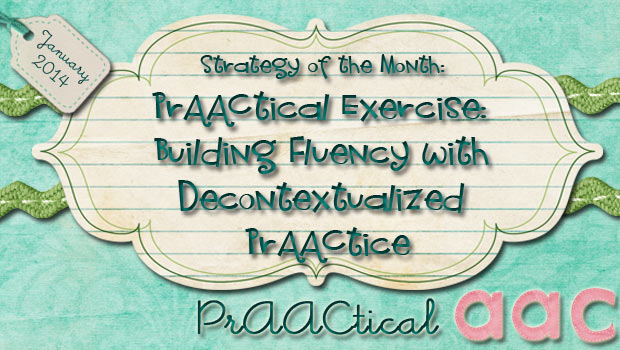
In most situations, communication teaching must be steeped in a meaningful context. SLPs build their plans for teaching new concepts or communicative intents around things that are relevant and important to the AAC learner. How do you teach ‘more’ without something the learner wants more of? How do you teach ‘fast’ without making something zip around? It just wouldn’t work. We get the role of context and have written many posts emphasizing the central part it must play in AAC intervention.
Is there are prAACtical place for therapy activities that are NOT embedded in a rich semantic context? We think so.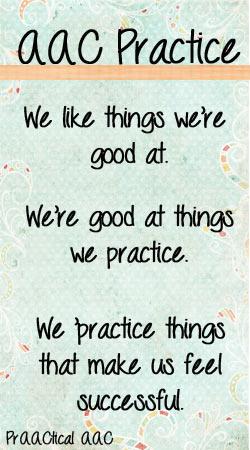
First, a word about what we mean when we talk about therapy activities that are decontextualized. We’re talking about activities in which there is not necessarily a connection between the semantics and the outcome for the AAC learner. (For example, saying a sentence with ‘more’ in it, does NOT get you more of something.) What it DOESN’T mean is boring. These activities should still be meaningful in the sense that they use materials and/or content that engage the AAC learner.
Why use decontextualized activities in AAC therapies? The main reason relates to the frequency of practice opportunities that the learner needs. When used appropriately, decontextualized prAACtice can significantly boost the number of times that the new skill is used. And, as we’ve been saying all month, frequent opportunities for practicing AAC skills is essential to developing fluency. Don’t get us wrong: Context is ESSENTIAL in the initial teaching of most AAC skills. But, for some clients and with some skills, decontextualized practice can boost skill acquisition.
Here are some examples of when decontextualized prAACtice has worked for us.
Warm-Up
Just like dancers and runners stretch before they perform or race, we help AAC learners limber up at the start of a session. For someone with access issues, we might start with a warm-up routine or have them use that routine outside of therapy to build their skills in accurately selecting messages. Here’s a routine similar to one used by a client who was learning to use eye gaze with a Picture WordPower. The idea was for her to limber up by selecting cells in the center and around the periphery as a way to get ready to do some AAC therapy. When she got into a routine of doing these warm-ups a few times/day, there was a noticeable difference in her accuracy and speed of selection.
Word Hunt
Ashley learned a number of core words in her therapy and uses them, but not as extensively as she could. We suspected fluency to be an issue and hypothesized that if we could make it easier to say those words, she would use them more often. How can we make it easier to say those words? Practice, practice, practice. Try making a game out of this by randomly choosing a word then taking turns to locate and say it on the SGD.
Adapted Games
Let’s face it – there aren’t a ton of ready-made AAC teaching materials. Creative clinicians adapt materials and use them effectively for a wide variety of intervention  activities. Look at materials developed for other purposes and see if there are ways to make them appropriate for the AAC skills you are trying to teach and practice. For example, let’s say that we are trying to strengthen motor planning and build fluency with possessive pronouns. We can certainly take a board game, like this SpiderMan edition of Chutes and Ladders, and adapt it to give practice saying those words. Maybe we can make a stack of ‘his/her’ cards and draw one to say the phrase (e.g., ‘his book,’ ‘her head’) before moving our game piece. We can also take ‘regular’ SLP materials designed for this purpose and make them AAC-friendly. We might take the playing cards from this set of materials developed by Jenna Rayburn at Speech Room News (her store) and place them on an All Turn It Spinner to randomly select which sentences to make. If you can find a game or set of materials that engages your prAACtical learner, there’s probably some way to use it for building AAC skills.
activities. Look at materials developed for other purposes and see if there are ways to make them appropriate for the AAC skills you are trying to teach and practice. For example, let’s say that we are trying to strengthen motor planning and build fluency with possessive pronouns. We can certainly take a board game, like this SpiderMan edition of Chutes and Ladders, and adapt it to give practice saying those words. Maybe we can make a stack of ‘his/her’ cards and draw one to say the phrase (e.g., ‘his book,’ ‘her head’) before moving our game piece. We can also take ‘regular’ SLP materials designed for this purpose and make them AAC-friendly. We might take the playing cards from this set of materials developed by Jenna Rayburn at Speech Room News (her store) and place them on an All Turn It Spinner to randomly select which sentences to make. If you can find a game or set of materials that engages your prAACtical learner, there’s probably some way to use it for building AAC skills.
Flash Cards and Flash Card Apps
There are so many free or low-cost flash card apps out there, chances are you probably already have at least one. Take a look and see if you can find a creative way to use them for AAC practice. Check out the ideas in this post.
Use a Fun App
It seems like there is an app for any area of interest. Find one that your client might enjoy and view it with a new lens, asking yourself “How can I use this to practice ___?” There may be a natural context within the app for that specific language skill to be used, such needing to make an ‘I want’ sentence to request things to feed the monster in Toca Kitchen Monsters or asking for a turn whenever the app moves to a new scene/activity. For that to be successful, you’ll need to build routine where you control the access to what the learner wants to do in the app while you elicit the desired skill. We’re excited to see that growing number of AAC therapy apps, such as PRC’s Language Lab: Core Words. We can easily use those to build practice opportunities for AAC learners who need to build fluency in saying certain words/sentences.
Final Thoughts
For some learners, there can be a more arbitrary connection between the app’s activities and saying the target word/sentence. For example, we might set up a routine where we say the target word/sentence before taking any turns. We used this strategy with Jonah, who got extra practice learning to ask “What is that?” whenever a new character or object appeared when we shopped with the Toca Store app. If you have an app that the client really enjoys, this can be a powerful way to get additional practice. Remember, though, this is for building fluency and not for initial teaching of the concept or word.
Is decontextualized (or semi-contextualized) prAACtice for everyone? Of course not. But it can be useful for many clients who have learned specific language skills but struggle because it takes so much cognitive and/or physical effort to say those things. Fluency takes practice, and practice is the key to making linguistic expression come easier to most AAC learners.
Do you have ideas for boosting the number of prAACtice opportunities that we haven’t mentioned here? We’d love it if you’d share those thoughts.
Filed under: Strategy of the Month
Tagged With: All Turn It, context, fluency, Opportunities, Picture WordPower, practice, Speech Room News, Toca Boca
This post was written by Carole Zangari
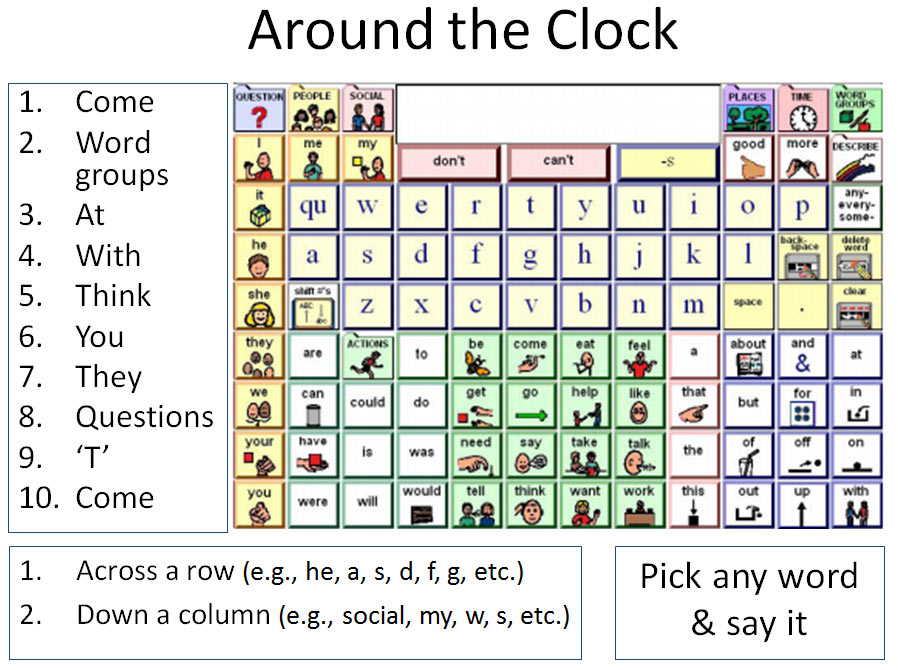
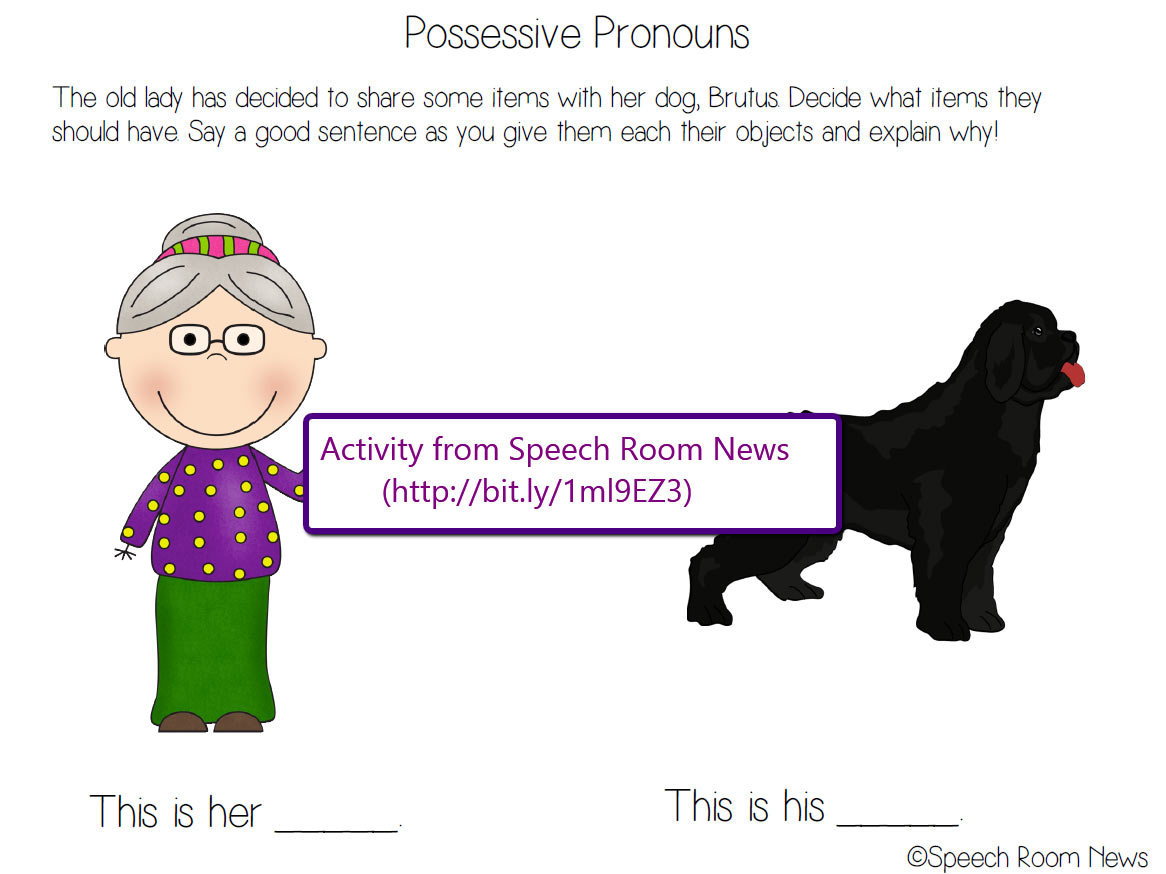

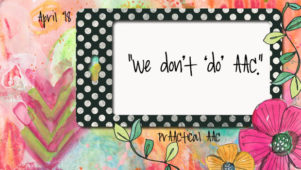
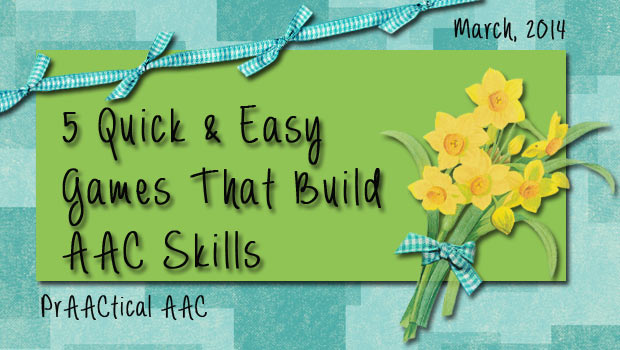
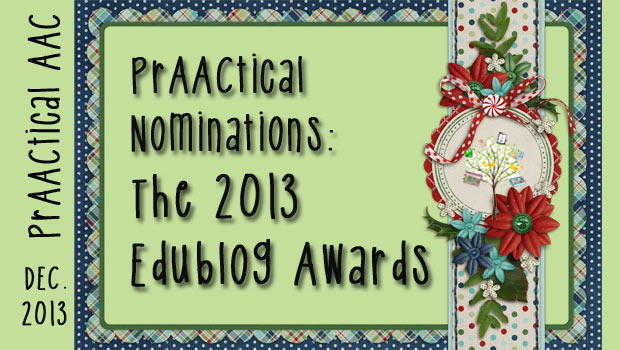
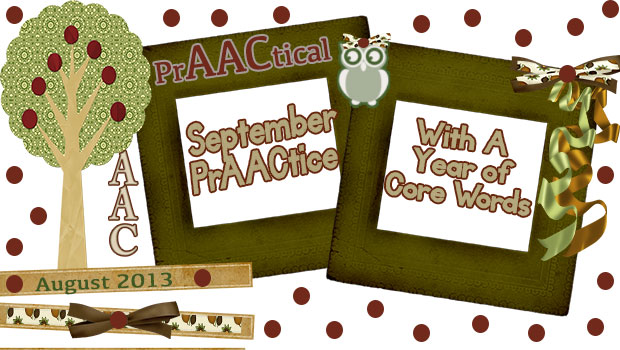
4 Comments
I love your slogan! “We like things we’re good at…We’re good at things we practice…We practice things that make us successful”. Did you coin that mantra? Is it your original? Just wondering, because it’s very practical and applicable to many educational endeavors. With your permission, may I use it too? I will credit you and/or the blog, of course, as the source for it.
Thanks for your comment, Margo. I’ve used this in my grad classes for years, but there are probably other versions out there. You are VERY welcome to use it, of course.
The more I read about this, the more I like it. “Around the Clock” is very accommodating with student choices. This gives students the opportunity to “show what they already know”, thus giving them confidence to try something a little more challenging. Practice is a given with every option. Nice!
Margo, I hadn’t thought of it as giving them an opportunity to show what they know. That’s a great way to look at it! Thanks for taking the time to share that thought.